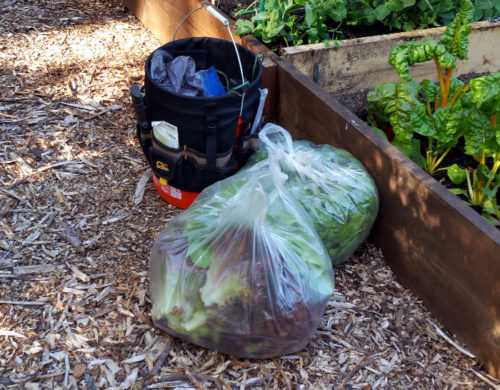Using Fiberglass Roofing Panels to Create a Mini Greenhouse, Extend the Season or Warm the Soil
A few weeks back we had a spell of warmer weather and I waited till the end of it to attempt a sowing of pole beans. A couple weeks after the fact I decided to look for the seed as nothing was coming up. I dug around and found…nothing. The soil didn’t look disturbed so I’m not thinking it was birds. I’m guessing it was just too cool and wet and the seed rotted. When the weather gods predicted another bout of warm weather I was on it. It occurred to me that I could possibly get a jump on sowing if I could warm the soil. Remembering a mini greenhouse I used in gardens past I made a trip to the lumber yard and came home with an 8′ long roofing panel. Once upon a time these used to be made out of fiberglass and perhaps you can still find them but any I’ve found locally have been PVC or ‘polycarbonate’. I’m hoping they will work as well (and last as long) as the fiberglass panels used to. I’ve used them to extend either end of the growing season when just a few degrees can make all the difference. My hope in using them this time is that they will help to warm the soil a few degrees so that the bush beans I plan to plant there will have a better shot at germinating should the weather cool again (a very real possibility around here).
Shopping List
- 1 clear or semi clear roofing panel. 26″ wide and the length of your choice. Mine was 8′ long
- 4 1″x2″x16″ stakes per panel
- length of wire or twine to secure the panel
Preparation and Installation
- Cut a 1/4″ notch into each of the stakes, a few inches from the top. This will insure that the wire or twine stays put. I cut my panel into 2 4′ sections but they can also be left whole.
- Once you decide where you want your panel to sit, drive two of the stakes into the ground approximately 6-12″ in from each end of one side of the panel.
Drive two more stakes in 12″ from the first two. If two panels are being installed next to each other you can use 2 less stakes as the middle stakes can secure both panels (see image). - Gently fold the panel into an upside down U shape and set it between the two stakes.
- Tie string or wire, crossing over the panels. Thats all there is to it!
Garden Happenings
Harvest

The Palco spinach is showing signs that it is about to bolt which necessitated harvesting that 1′ wide bed. Since I wanted the space on either side of it I decided to harvest one of the beds of the Mild Mesclun mix that was ready. I also harvested the rest of the red and butter lettuce from the bed next to the peas. I ended up with two large bags of green goodness, one filled with lettuce and the other with spinach and kale. Way more than we will ever eat I decided to fill some 1 gallon bags for the local food bank. I ended up getting 8 1 gallon bags in total. 3 spinach, 2 kale and 4 lettuce. 8 to go to Helpline and 1 bag of spinach for us.
Sowing
It may be too warm but I sowed two short rows of Renee’s Farmer’s Market Blend lettuce in the shade of the peas.
On the balcony I started a pot of SMR-58 cukes, Astia zucchini and another attempt at “Italian Pesto basil. ALL of the batch I started inside this spring ended up dying. Not sure if it was a rot or ? Need to investigate that.